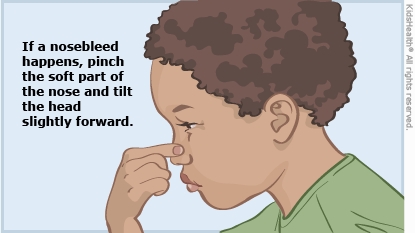Nosebleeds
Article Translations: (Spanish)
Nosebleeds are common in kids 3 to 10 years old, and most are caused by nose-picking or dry air. They can be scary, but usually aren't serious. Most will stop on their own and can be cared for at home.
What to Do:
- Stay calm and reassure your child.
- Have your child sit upright in a chair or on your lap, then tilt his or her head slightly forward.
- Do not have your child lean back. This may cause blood to flow down the back of the throat, which tastes bad and may cause gagging, coughing, or vomiting.
- Gently pinch the soft part of the nose (just below the bony ridge) with a tissue or clean washcloth.
- Keep pressure on the nose for about 10 minutes; if you stop too soon, bleeding may start again.
- Have your child relax a while after a nosebleed. Discourage nose-blowing, picking, or rubbing, and any rough play.

Call the Doctor if Your Child:
- has nosebleeds often
- may have put something in his or her nose
- tends to bruise easily
- has heavy bleeding from minor wounds or bleeding from another place, such as the gums
- recently started taking new medicine
Get Emergency Care or Call the Doctor if Bleeding:
- is heavy, or your child also has dizziness or weakness
- is the result of a fall or blow to the head
- doesn't stop after two attempts of applying pressure for 10 minutes each
Different Kinds of Nosebleeds
The most common kind of nosebleed is an anterior nosebleed, which comes from the front of the nose. Capillaries, or very small blood vessels, inside the nose may break and bleed, causing this type of nosebleed.
A posterior nosebleed comes from the deepest part of the nose. Blood flows down the back of the throat even if the person is sitting or standing. Kids rarely have posterior nosebleeds. They're more common in older adults, those with high blood pressure, and people who have had nose or face injuries.
What Causes Nosebleeds?
Most anterior nosebleeds are due to dry air. A dry climate or heated indoor air irritates and dries out nasal membranes. This causes crusts that may itch, then bleed when scratched or picked. Common colds also can irritate the lining of the nose, with bleeding following repeated nose-blowing. Having a cold during dry winter weather is the perfect formula for nosebleeds.
Allergies also can cause problems, as doctors may prescribe medicine (such as antihistamines or decongestants) to control an itchy, runny, or stuffy nose. The medicine can dry out nasal membranes, leading to nosebleeds.
An injury or blow to the nose can cause bleeding, but most aren't a serious problem. But if your child has a facial injury that causes a bloody nose and you can't stop the bleeding after 10 minutes or have other concerns about the injury, get medical care right away.
While nosebleeds are rarely serious, there might be a problem if they happen a lot. If your child gets nosebleeds more than once a week, call your doctor. Usually, frequent nosebleeds are easily treated. Sometimes tiny blood vessels inside the nose are irritated and don't heal, which happens more often in kids with ongoing allergies or who get a lot of colds. A doctor might be able to help in these cases.
For bleeding not due to a sinus infection, allergies, or irritated blood vessels, a doctor may order tests to find the cause. Rarely, a bleeding disorder or abnormally formed blood vessels could be a possibility.
Can Nosebleeds Be Prevented?
Since most nosebleeds in kids are caused by nose-picking or irritation from hot dry air, using a few simple tips may help your kids avoid them:
- Keep your child's nails short to prevent injuries from nose-picking.
- Keep the inside of your child's nose moist with saline (saltwater) nasal spray or gel, or dab petroleum jelly or antibiotic ointment gently around the opening of the nostrils.
- Run a cool-mist humidifier (or vaporizer) in bedrooms if the air in your home is dry. Keep the machine clean to prevent mildew buildup.
- Make sure your kids wear protective athletic equipment during sports or other activities that could cause a nose injury.
Even with proper precautions, kids can still get a bloody nose occasionally. So if your child gets a nosebleed, try not to panic. They're usually harmless and are almost always easy to stop.
Note: All information is for educational purposes only. For specific medical advice, diagnoses, and treatment, consult your doctor.
© 1995-2024 KidsHealth ® All rights reserved. Images provided by iStock, Getty Images, Corbis, Veer, Science Photo Library, Science Source Images, Shutterstock, and Clipart.com

